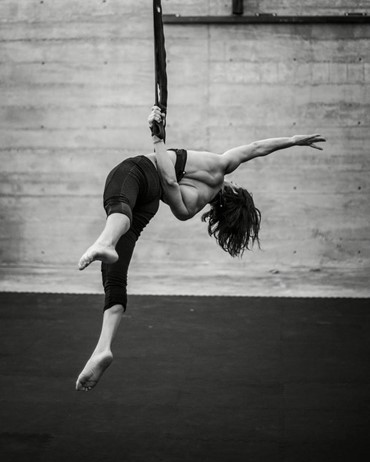29 Mar Aerialist Physio Best Tips
Jessica Banks, our aerialist physio, outlines what is required for the aerialist shoulder. She knows first hand the demands, as being both a highly skilled physiotherapist and a trained aerialist herself.
What is an aerialist?
This is a performer, athlete and artist that uses apparatus to perform tricks, drops, climbs and more above the ground.
The types of apparatus used varies greatly from trapeze, silks, lyra, strap, Chinese pole, clown slings, aerial nets and more. Each apparatus requires different skills, strengths, and abilities of the aerialist. Most skills usually have to place high demands on their shoulder, pushing their bodies to the extremes.

An example of a skill the places high demands on shoulder mobility and strength is a single arm coathanger – usually performed on straps (see above).
For an athlete to perform efficiently, they require at the shoulder:
1. Mobility
Our shoulder is a highly mobile joint, being a ‘ball and socket’ joint and moving through all degrees of movement. For an aerialist, the mobility or flexibility is extremely important to help get them into positions to perform different skills. This mobility is required in the shoulder joint (gleno-humeral joint), scapula and spine (thoracic). And it requires both joint mobility and muscle flexibility.
2. Strength
A strong shoulder is extremely important to execute the skills, and involves different components depending on what the athlete is performing. Typically, the types a strength required, includes:
- Static (isometric) strength. This is the ability to hold the same position over a period of time.
- Explosive (plyometric) strength. This is the ability to generate force quickly.
- Endurance strength. This the ability to maintain strength over a period of time.
Where do people train to be an aerialist?
There are a variety of different locations to train. Some places include:
- Cirque Fit
- Nica
- The Circus Spot
- Vibes Fitness
- Pole and Aerial Divas Richmond
- TrainStation Dance and Fitness
- Little Devils Circus
- Fly factory
Best physiotherapist for performers and circus artists
What makes us the best aerialist physio?
What type of Aerialist is Jess? Jess’ current main apparatus is aerial silks, however she has previously trained lyra, static trapeze and clown swing. When she was performing, she used to train 3-4+ times a week, but only trains once a week at the moment.
A normal aerials class for Jess usually consists of:
- warm up and stretching
- strength and conditioning
- climbs
- Tricks and drops
- Cool down and stretching
So see some of the awesome moves and training Jess does FOLLOW HER INSTAGRAM ‘PERFORMING.ATHLETE.PHYSIO’ HERE


